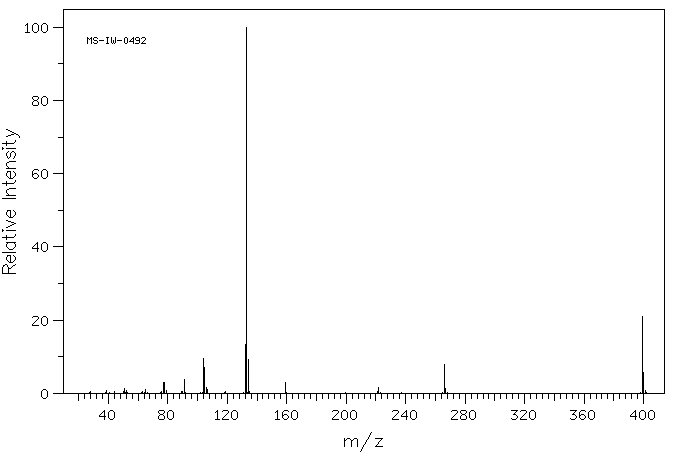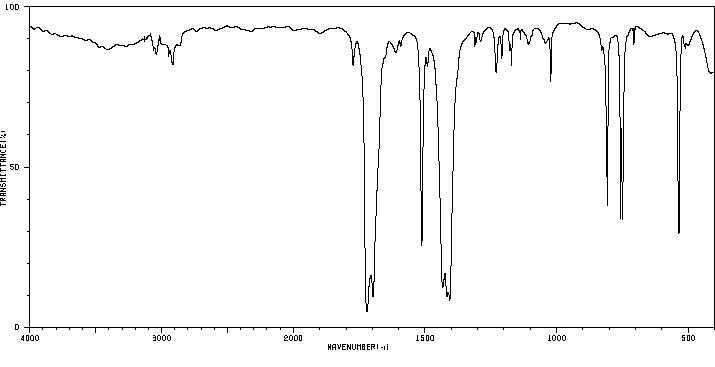1,3,5-tris(4-methylphenyl)-1,3,5-triazinane-2,4,6-trione | 1785-03-1
中文名称
——
中文别名
——
英文名称
1,3,5-tris(4-methylphenyl)-1,3,5-triazinane-2,4,6-trione
英文别名
1,3,5-tris(4-methlyphenyl)-1,3,5-triazinane-2,4,6-trion;1,3,5-tris(p-tolyl)-1,3,5-triazinane-2,4,6-trione;1,3,5-tri-p-tolyl-[1,3,5]triazine-2,4,6-trione;N,N',N"-tris-(p-tolyl) isocyanurate;N,N',N''-tris-(p-tolyl)isocyanurate;N,N',N''-tri(p-tolyl)isocyanurate
CAS
1785-03-1
化学式
C24H21N3O3
mdl
——
分子量
399.449
InChiKey
GEPCRFVQDHGHNE-UHFFFAOYSA-N
BEILSTEIN
——
EINECS
——
-
物化性质
-
计算性质
-
ADMET
-
安全信息
-
SDS
-
制备方法与用途
-
上下游信息
-
文献信息
-
表征谱图
-
同类化合物
-
相关功能分类
-
相关结构分类
计算性质
-
辛醇/水分配系数(LogP):5.1
-
重原子数:30
-
可旋转键数:3
-
环数:4.0
-
sp3杂化的碳原子比例:0.12
-
拓扑面积:60.9
-
氢给体数:0
-
氢受体数:3
SDS
反应信息
-
作为产物:参考文献:名称:含有双齿吡咯配体的钾配合物:异氰酸酯环三聚的合成,结构和催化活性†摘要:二齿配位体吡咯,2-(吨-butyliminomethyl)吡咯和2-(吨-butylaminomethyl)吡咯,用KH反应,得到配合物[C 4 H ^ 3 N(2-CH Ñ吨卜)K(THF)] Ñ(1)和[C 4 H 3 N(2-CH 2 NH t Bu)K] n(2)。每一种都通过C,H和N微分析,NMR光谱和单晶X射线结构分析来表征。配合物1(n≥1)证明它以固态形式以1D之字形配位聚合物形式存在。相反,复杂的结构2(Ñ ≥1)表明,它是一个二维超分子网络。它们被证明是在温和条件下以优异的收率进行异氰酸酯环三聚的有效催化剂。DOI:10.1039/c9dt01246j
文献信息
-
Amine-Linked N-Heterocyclic Carbenes: The Importance of an Pendant Free-Amine Auxiliary in Assisting the Catalytic Reaction作者:Chia-Yi Li、Yi-Yin Kuo、Jie-Hong Tsai、Glenn P. A. Yap、Tiow-Gan OngDOI:10.1002/asia.201000829日期:2011.6.6amine group, leading to insight about the instability of NHCs arising from the intermolecular interaction of the dangling amine side‐arm. However, the pendant amine plays an important role with respect to the catalytic process, resuscitating the catalytic activity of unsaturated NHC’s through a synergistic effect invoked by the secondary amine. This proof of concept allows us to expand the spectrum of我们已经成功地扩展了胺基上具有不同取代基的氨基-NHC库,从而使人们对悬空的胺侧臂之间的分子间相互作用引起的NHC不稳定性有了更深入的了解。然而,侧链胺在催化过程中起着重要作用,通过仲胺引起的协同作用来恢复不饱和NHC的催化活性。这一概念证明使我们能够将催化范围扩展到C CC以及CB键的形成。
-
Triaryl-1,3,5-triazinane-2,4,6-triones (Isocyanurates) Peripherally Functionalized by Donor Groups: Synthesis and Study of Their Linear and Nonlinear Optical Properties作者:Gilles Argouarch、Romain Veillard、Thierry Roisnel、Anissa Amar、Hacène Meghezzi、Abdou Boucekkine、Vincent Hugues、Olivier Mongin、Mireille Blanchard-Desce、Frédéric PaulDOI:10.1002/chem.201200484日期:2012.9.10The linear optical (LO) and nonlinear optical (NLO) properties of a series of isocyanurates functionalized by donor arms at the periphery are reported herein. These octupolar derivatives were obtained in a straightforward way from commercial isocyanate derivatives and were fully characterized. Although several of these compounds are known, those that exhibited the largest NLO activities are all new本文报道了在外围通过供体臂官能化的一系列异氰脲酸酯的线性光学(LO)和非线性光学(NLO)性质。这些八极衍生物是直接从商业异氰酸酯衍生物获得的,并已进行了充分表征。尽管这些化合物中的几种是已知的,但显示出最大的NLO活性的化合物都是新化合物。在二阶活性方面,这些衍生物中的几种表现出显着的活性/透明度权衡。就三阶活性而言,较长的衍生物具有较强的供体基团(X = NH 2,NMe 2或NPh 2)被证明具有明显的两光子吸收截面。这些强烈发光的衍生物具有高达410 GM的双光子吸收截面。还进行了DFT计算以阐明其电子结构并合理化其NLO特性。据我们所知,本研究首先涉及这些原始环三聚体的非线性光学性质。
-
Cyclic tetramers of a five-membered palladacycle based on a head-to-tail-linked isocyanate dimer and their reactivity in cyclotrimerization of isocyanates作者:Seon Gye Lee、Keun-Young Choi、Yong-Joo Kim、SuJin Park、Soon W. LeeDOI:10.1039/c5dt00534e日期:——Reactions of [Pd(styrene)(PR3)2], generated from trans-[PdEt2(PR3)2] and styrene, with 2 equiv. of benzyl isocyanate in THF at room-temperature afforded unusual cyclic Pd-tetramers of five-membered rings consisting of organic isocyanate dimers and palladium, [Pd(PR3)–C(O)N(R)C(O)N(R)–}]4 (PR3 = PMe3, 1; PR3 = PMe2Ph, 2). Additionally, a cyclic trimer, (RNCO)3, 3 (R = benzyl) was produced as a catalytic的反应[钯(苯乙烯)(PR 3)2 ],从生成的反式- [PDET 2(PR 3)2 ]和苯乙烯,与2当量 室温下将异氰酸苄酯在THF中制得的五元环的非常规环状Pd-四聚体由有机异氰酸酯二聚体和钯组成,[Pd(PR 3)– C(O)N(R)C(O)N( R) - }] 4(PR 3 = PME 3,1 ; PR 3 = PME 2 PH,2)。另外,环状三聚体,(RNCO)3,3(R =苄基)作为催化产物产生。用4当量处理环状四聚体(1)。(1,2-双(二乙基膦基)乙烷)(DEPE)或(1,2-双(二甲基膦基)乙烷)(DMPE)等螯合膦容易引起金属环顺式[Pd N (R)C(O)N(R)C(O)}(P〜P)](P〜P = DEPE,4 ; P〜P = DMPE,5)以定量产率计算。相反,Pd(0)-PR 3与2当量的反应。N- CO (Ar = Ph,p - tolyl ,p -ClC
-
Reactivities of zero-valent group 10 complexes toward organic isocyanates: synthesis of metallacycles containing dimeric isocyanate units, isocyanate cyclotrimerization, and computational chemistry作者:Young-Sung Han、Kang-Yeoun Jung、Yong-Joo Kim、Kyoung Koo Baeck、Gang Min Lee、Soon W. LeeDOI:10.1039/c9nj03332g日期:——4-methoxybenzyl), depending on the alkyl substituent on R-NCO. Interestingly, these reactions afford cyclic trimers as catalytic products when two equivalents or excess amounts of benzyl isocyanate are used. In contrast, reactions of [Pt(olefin)(PR3)2] with two equivalents of an alkyl or aryl isocyanate afford only the five-membered platinacycle, namely cis-[Pt–N(R)C(O)N(R)C(O)–}(PMe3)2] (R = 3-methylbenzyl[Pd(烯烃)(PR 3)2 ](PR 3 = PMe 3,PMe 2 Ph)与两当量的芳基或异氰酸烷基酯的反应提供顺式-[Pd –N(R)C(O)N (R)C(O)–}(PR 3)2 ](R = 1-萘基,4-苯氧基苯基),它们是带有二聚异氰酸酯单元的五元帕拉达环,或作为四个五元帕拉达环的组装体的环状四聚体, [Pd C(O)N(R')C(O)N(R')}(PMe 3)] 4,(R'= 3-甲基苄基,4-甲基苄基或4-甲氧基苄基),取决于R-NCO上的烷基取代基。有趣的是,当使用两个当量或过量的异氰酸苄酯时,这些反应提供环状三聚体作为催化产物。相比之下,[Pt(烯烃)(PR 3)2 ]与两当量的烷基或芳基异氰酸酯的反应仅提供五元铂盐环,即顺式-[Pt –N(R)C(O)N( R)C(O)–}(PMe 3)2 ](R = 3-甲基苄基,4-甲基苄基,4-氟苄基,4-甲氧基苄基,(S)
-
Macrocyclic complexes containing a platinacycle or palladacycle composed of an isocyanate dimer unit: Reactivity towards isocyanides and cyclotrimerization of isocyanates作者:Jun-Hwan Choi、Kang-Yeoun Jung、Yong-Joo Kim、Hye Jin Im、Soon W. LeeDOI:10.1016/j.poly.2016.05.061日期:2016.10cyclic products as an assembly of four platinacycles or palladacycles, [M(PR3)–N(R)C(O)N(R)C(O)–}]4, were readily obtained. These cyclic tetramers were cleaved using tert-butyl isocyanide (CN–tbutyl, 4 equiv.), affording the corresponding monomeric complexes, [M(PR3)(CN–tbutyl)–N(R)C(O)N(R)C(O)–}] (M = Pt, Pd). An unusual cyclotrimerization of organic isocyanates catalyzed by zerovalent Pt complexes摘要[Pt(苯乙烯)(PMe3)2]与2当量的反应。的五元铂盐环烷基或芳基异氰酸酯,顺式-[Pt –N(R)C(O)N(R)C(O)–}(PMe3)2](R = CH2C6H5,p-ClC6H4,p -OMeC6H4)。这些络合物是含有异氰酸酯二聚体单元的铂环化合物的第一个实例。当五元双(膦)platinacycles或palladacycles用2当量处理时。容易获得由四个platinacycles或palladacycles,[M(PR3)– N(R)C(O)N(R)C(O)–}] 4组成的元素硫,16元环状产物。这些环状四聚体使用叔丁基异氰化物(CN-叔丁基,当量为4当量)裂解,得到相应的单体络合物,[M(PR3)(CN-叔丁基)– N(R)C(O)N(R) C(O)–}](M = Pt,Pd)。观察到由零价Pt络合物或五元铂环化合物催化的有机异氰酸酯的异常环三聚。此外,还研究
表征谱图
-
氢谱1HNMR
-
质谱MS
-
碳谱13CNMR
-
红外IR
-
拉曼Raman
-
峰位数据
-
峰位匹配
-
表征信息
同类化合物
阿马诺嗪
阿特拉通
阿特拉津-乙氨基-15N1
阿特拉津-D5 同位素
阿特拉津
阿特拉嗪去异丙基-2-羟基
阿扎丙宗
达卡巴嗪相关物质B
败脂酸,丙-2-烯腈,苯乙烯
西草净亚砜
西草净
西玛津
螺拉秦
蜜勒胺
莠灭净
莠去津-特丁净混合物
莠去津-13C3
莠去津
草达津-2-羟基
草达津
苯酚,2-(4-氨基-6-乙氧基-1,3,5-三嗪-2-基)-
苯并呋喃,2-环丙基-
苯基-1,3,5-三嗪
苯嗪草酮-DESAMINO
苯嗪草酮
肼基氰尿酸盐
聚磷酸三聚氰胺
聚[[6-[(1,1,3,3-四甲基丁基)氨基]-1,3,5-三嗪-2,4-二基][(2,2,6,6-四甲基-4-哌啶基)亚氨基]-1,6-己二基[(2,2,6,6-四甲基-4-哌啶基)亚氨]]
聚(氧代-1,2-乙二氧基羰基-2,6-萘二基羰基)
羟硝基
美拉肼
美司钠EP杂质E
硫酸三聚氰胺
癸基-(二氯-[1,3,5]三嗪-2-基)-胺
甲氧丙净
甲基[2-(苯甲基氨基)-4-(4-氯苯基)-1,3-噻唑-5-基]乙酸酯
甲基6-甲基-1,2,3-三嗪-4-羧酸酯
甲基5-甲基-1,2,3-三嗪-4-羧酸酯
甲基-[1,2,4]噻嗪-3-基-胺
甲基(4Z)-4-(羟基亚胺)-2-甲基-4,5-二氢-1H-咪唑-1-羧酸酯
甲基(2E)-3-吖丙啶-1-基丙-2-烯酸酯
环氯胍硝酸盐
环氯胍
环己基三聚氰胺
环己基-(1-氧代-苯并[1,2,4]三嗪-3-基)-胺
环丙胺,N-[2-[(4-甲基苯基)硫代]乙基]-
环丙津-脱异丙基
环丙津-2-羟基
环丙津
环丙氨嗪-D4








